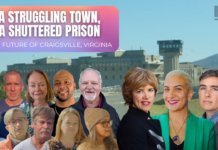Under the view of the iconic Hollywood Sign, a struggle is being waged over the future of policing and incarceration. Los Angeles is ground zero for fights over the job of District Attorney, Police Chief, and the size of prisons and jails. It recently became one of the only cities in the US to cancel construction of a jail. Activists have forced out two police chiefs, while conservatives have brought two recall petitions against the DA. Corporations that have profited from prison communications are now profiting on electronic monitoring. And in this election year, with criminal justice reform a major issue, how are activists pushing back against false narratives on crime? Looking at the fight inside and outside the system, Laura Flanders talks to activists and elected officials in Los Angeles. All this from the city where SWAT teams were invented, from the state where Ronald Reagan and Richard Nixon launched their careers, and the nationwide boom in prison construction was born. Can today’s Los Angeles change the script?
“Los Angeles has a history of repression, and I think because it’s Los Angeles, they’re also masters at narrative, so they’ll mask it with pictures of palm trees and Venice Beach and all of these other things. But really, when we look at the history of Los Angeles, it’s deeply rooted in racism, deeply rooted in racist repression and oppression, and deeply rooted in a system of policing that absolutely descends from slave catching,” – Melina Abdullah
“When we talk about closing Men’s Central Jail, yes, we’re trying to close that particular building, but what it requires is every jail in our county to reduce its population . . . We’re trying to decarcerate globally across the jail system, that will then allow us to close this monument of essentially torture in our communities.” – Mark-Anthony Clayton-Johnson
“The reason why I’ve done this work is because I’ve seen how the system works, and I’ve seen how it doesn’t prevent harm and violence. It only responds to it . . .” – Eunisses Hernandez
“What if something went off and said that I wasn’t where I was supposed to be, and all these cops showed up? . . . At 15 thinking the cops are going to show up . . . that is one thing that I will always say that shamed me in my life. I felt unworthy. I felt like I was a bad person.” – Sheila Natt
“. . . 94% of the people that are terminated from the electronic monitoring program pre-trial are terminated on technical violations . . . If the point is to use this electronic monitoring to help people stay out of jail and come to court, why are the technical violations leading you right back into jail?” – Anthony Robles
Update: In the course of reporting our episode, Laura Flanders & Friends wrote to Securus, the security company we mention, and asked for confirmation of their prison-related revenue, and their response to the contention that electronic monitoring is turning communities into cages. After deadline, we received the following:
LAURA FLANDERS & FRIENDS
Corporate Prison Reform Will Not Keep Us Safe: A Report from Los Angeles
LAURA FLANDERS: Four years ago, corporations were saying, “Black Lives Matter,” and police departments like this one were under pressure to reform. Today, Republicans are using fear of violent crime as an election campaign issue once again, and Democrats are mostly distancing themselves from calls to defund the police. All the while monitoring technology is being promoted as a way to reduce prison numbers. Is it a step forward? We’ve come to Los Angeles to find out more and dispel some myths about safety and technology. For “Laura Flanders & Friends,” I’m Laura. Welcome.
– The first official building in the county of Los Angeles was a jail.
– If you have a cell phone in your hand, if you have a key, anything could be confused with a weapon. You can just be killed for stepping outside.
– We know that in every single instance when we talk about the safest communities, they’re the communities with the most resources, not the most police and not the most prisons.
– 15, 20 years ago, this conversation was not happening.
– I think Los Angeles has the potential to be a leader in decarceration.
LAURA FLANDERS: While the media say it can’t be done, a coalition called Justice LA with 60 organizations is leading the campaign to end mass incarceration in Los Angeles, and winning with voters. Here at the LA Board of Supervisors, something remarkable happened in 2019. The elected representatives of this city voted to cancel a contract for a new jail. In the state that led this country when it comes to incarcerating people, this was truly a turning of the tide.
– : Incarceration is itself an experiment, and it’s an experiment that has failed.
– The motion carries four to one.
– Okay?
EUNISSES HERNANDEZ: When we stopped the jail construction contract, the population was hovering between 15 to 17,000 people every single day. And now we’ve seen that the population has been reduced by thousands.
LAURA FLANDERS: Eunisses Hernande was one of those testifying that day. Now she sits on the Los Angeles Board of Supervisors representing nearly 2 million people, more constituents than the governors of some states.
EUNISSES HERNANDEZ: The reason why I’ve done this work is because I’ve seen how the system works, and I’ve seen how it doesn’t prevent harm and violence. It only responds to it. This work is personal. The reason why I’ve dedicated myself to that through my career and even now through the work I do and trying to push a care first agenda, is that I’m a survivor of sexual violence. A lot of my friends and family have been impacted by problematic substance use, incarceration, and you know, I’ve had to lean on the criminal justice system for help when there was intimate violence happening in my home and you know, was met with, “Well, we have more important things to do.” What I tell people is, in no other moment in history have we given the police more money than we do today, and you are telling me that you don’t feel safe. And so I do think we need to reassess our budget. If we aren’t putting our money into things that are not making you feel safe, then we need to reassess. Is that the best way to use our dollars? How much more money do you want to give to the system that right now it doesn’t make you feel safe? Our budgets are a statement of our values, and here in the city of Los Angeles, we give nearly a quarter of our budget to one department, which is the LAPD. We spent $6 million on police uniforms last year and only $2.3 million in the entire youth development department, that’s supposed to be serving 800,000 young people in the city of LA. We’ve changed laws that have reduced the sentence for different types of crimes and offenses, but what we haven’t done is back that up with significant social safety net. We haven’t invested in deeply affordable housing. We haven’t invested enough in removing the collateral consequences of a criminal conviction that prevents you from getting housing, employment, and other supportive services. We haven’t invested in preventing harm and violence at the scale that we need to, and that’s why I feel like we are in the situation here today where there’s a lot of desperation in our communities. People cannot afford to live here in the city of Los Angeles anymore, and they’re moving out. We are causing situations of desperation for young people. In 2016, we saw that the top five charges for the incarceration of women in LA County was driving with a suspended license, no license, drug related offenses. In my first month in office last year, we saw LAPD kill three people in a matter of 10 days, all having mental health crises.
LAURA FLANDERS: The Men’s Central Jail here in Los Angeles is one of the biggest in the world. Dozens of people die here every year. The sheriff’s department, which runs this facility, has a budget of $4 billion. Activists are calling for that money to be redirected and this place to be closed. Mark-Anthony Clayton-Johnson is the co-executive director of Dignity & Power Now, the anchor organization of JusticeLA. He’s focused on the next steps for the movement.
MARK-ANTHONY CLAYTON-JOHNSON: There’s been agreement for decades that Men’s Central Jail needs to close. It is a torturous dungeon that does not produce safety, accountability, wellbeing, for anybody. So we’re working to close it because it’s our largest jail. At certain points in our history, held over 4,000 people. We started organizing around sheriff violence in the jails, specifically thinking about sheriff violence as not just brutality against our loved ones inside of the county jails, but also medical negligence and jail construction itself. The actual buildings and infrastructure of the sheriff’s department is a site of violence. And so for the last 12 years, we’ve been organizing and bringing in families and survivors of violence in the jails to challenge that and really move resources to where they belong in the hands of communities and wellbeing. And that for us, has required building large tents and bringing people into those tents and bringing people into those vehicles, which we call coalitions. I think when we talk about closing Men’s Central Jail, yes, we’re trying to close that particular building, but what it requires is every jail in our county to reduce its population. That means Twin Towers, that means the Women’s Jail, that means the Pitchess Facility. And so we’re trying to decarcerate globally across the jail system that will then allow us to close this monument to essentially torture in our communities.
LAURA FLANDERS: We’ve heard, well, all that criminal justice reform work that happened in 2020 backfired, we saw increased violence, increased crime.
MARK-ANTHONY CLAYTON-JOHNSON: Yeah.
LAURA FLANDERS: Those DAs that took on criminal justice reform or bail reform even as an issue, were voted out of office. What’s fact, what’s fiction in all of that?
MARK-ANTHONY CLAYTON-JOHNSON: What we’ve seen time and time again is that particularly in this year, in this election year, that misinformation is being used a lot. I mean, I’m sure you’ve seen it, right? Like the whole smash and grab argument is being used a lot.
– The recent string of smash and grab robberies.
– Smash and grab robberies.
– Smash and grab robberies.
– Smash and grab.
– Smash and grab.
– Smash and grab.
– Smash and grab.
– Smash and grabs.
– This is an example of organized retail theft.
– Organized retail theft.
– Organized crime.
– Organized crime.
MARK-ANTHONY CLAYTON-JOHNSON: Many of these corporations lied about the degree to which retail theft is happening. We understand that what we’re up against is not a argument that is based on facts, it’s based on power. We spent the March primary talking to voters and knocking on almost 4,000 doors, arc of conversations, and we had over 800 of them. 90% of those people said close the jail. In 2020, March of 2020, we put a ballot measure in front of voters that said, do you want LA County to spend $3.5 billion on a jail or do you want alternatives? Voters said, “No.” By 72% of LA County voters for a city and a county that has innovated policing, that has refined it, that has beta tested strategies and policies that have resulted in people being incarcerated. For us to win this type of victory with an acknowledgement that it comes with reducing police contact in people’s lives, that’s pretty huge. It’s not a small thing that Gascon came out on top, even though there will be a runoff after surviving two recalls, after being told that Gascon’s policies is letting murderers and rapists loose.
– In 2020, Los Angeles County voters elected a lunatic to be the county’s top prosecutor. This is Los Angeles under George Gascon. You do the crime, you will not do the time. People who break the law are celebrating.
MARK-ANTHONY CLAYTON-JOHNSON: It’s not a small thing that voters made that decision amidst all these lies around $0 bail and smash and grab, but it’s consistent with everything that we know voters to be saying. That same year, we asked voters, do you want to secure 10% of our county budget for non-law enforcement alternatives to incarceration? Voters overwhelmingly said, “Yes.” That was in a year where sheriffs were telling us homicides were up, that violence was up. And so the instinct for what is correct and what people deserve is very much alive and well in voters. And so the electeds who are running their campaigns, I think need to be more in tune with that. It can be a lot more courageous about standing on not just what voters want, but also what works.
LAURA FLANDERS: While voters overwhelmingly supported non-law enforcement alternatives to incarceration, companies that make money from prison contracts are pushing electronic monitoring as that alternative. Securus, for example, one of two corporations that control 80% of prison telecom business makes monitors too. And it’s an area of rising profits.
MARK-ANTHONY CLAYTON-JOHNSON: There’s been a very harmful increase of electronic monitoring, which we’re in current battles now to reduce. The Department of Probation uses electronic monitoring when people are released constantly. And that’s a driver of incarceration. It’s one of the things that keeps our jail population so high that ends up undermining people’s ability to stabilize their lives, have access to resources.
EUNISSES HERNANDEZ: We’re in the middle of a pendulum swing where you see the bureaucracy, you see the carceral system trying to remain the same, trying to keep its stronghold, both because of special interests, because of different representatives of companies, but also the amount of money that these agencies and stakeolders receive through our different budgets from the state to the county to the city. And so the carceral system is trying to stay the same and keep its power.
LAURA FLANDERS: As the business of mass incarceration shifts, the corporations that currently make money from prisons are seeking to profit from new surveillance technology too. These companies tell us that electronic monitoring is the future of crime and punishment. People who’ve been under electronic monitoring tell me that instead of leading to freedom and safety, it’s actually a way of turning communities into cages. Anthony Robles is a youth and community organizer with Dignity and Power Now. He was put on an electronic monitor not long ago after a traffic stop.
ANTHONY ROBLES: Growing up in poverty, you know, there’s just a lot of odds, feel like that are against you. I would get stopped for driving for fix-it tickets. It would say your light, your light is out, or your license plate lamp is out. I didn’t even know a license plate needed a lamp or your tail light’s out, or I would get pulled over for having a air freshener hanging on my rear view mirror. They put me on pretrial supervision and with that they put a monitor, a bracelet on my ankle to track everywhere that I went. And at the time, I was also in a car accident and I broke both my legs and I was going to physical therapy, and they put in a monitor on my leg. I didn’t pose no flight risk. I was literally, my legs were, I was immobile, physically immobile, and obviously didn’t pose a threat. In my personal experience this thing did not help me get to court. It didn’t do anything except shame me, make me feel embarrassed to even go outside.
LAURA FLANDERS: These issues around electronic monitoring are becoming more widespread as the practice rises in popularity with city governments. From 2015 to 2021, electronic monitoring increased by over 5000%.
ANTHONY ROBLES: 94% of the people that are terminated from the electronic monitoring program pretrial are terminated on technical violations. Meaning they didn’t commit no crime, they didn’t do anything unlawful. They just violated something that was in the contract with the court and the probation department that put them on electronic monitoring, which then leads them to arrest and incarceration anyways. So if the point is to use this electronic monitoring to help people stay outta jail and come to court, why is the technical violations just leading you right back into jail?
LAURA FLANDERS: And in your case, for example, you wore it for six months and in those six months you could have been out on your own recognizance without the machine.
ANTHONY ROBLES: Mm-hmm.
LAURA FLANDERS: If you had violated some of the agreement related to the machine, to the monitor, you could have ended up in jail when your original sentence didn’t require that.
ANTHONY ROBLES: Yeah, exactly.
LAURA FLANDERS: Sheila Natt was put on an ankle monitor as a teenager. 30 years later, she still trembles at the memory.
SHEILA NATT: I am 44 today. I was 15 and just talking about it now, still it, I can’t stop fidgeting. I know that’s like, it shows this sign of anxiety and I think I’ve been doing pretty well with that, but.
LAURA FLANDERS: Can you tell us how that story began?
SHEILA NATT: I was 15, I was in high school. I was in class, and I remember the school police came and pulled me outta class about a disagreement that I had with a friend. I can’t recall everything that was going on, but I remember them putting me in handcuffs and in high school I wore heels a lot. I was one of those girls that dressed up for school. And some officers came and they drove me to Van Nuys Police Station. Then I remember being put on a bus and being taken to Sylmar Juvenile Hall, and there, I remember standing there for seven days.
LAURA FLANDERS: Here you are, you’re 15, you’ve been pulled outta school. You’re not quite sure why. You’ve been given a glimpse of the juvenile detention center jail.
SHEILA NATT: Mm-hmm.
LAURA FLANDERS: And finally you’re in a room with this thing being put on your leg and with all these rules.
SHEILA NATT: Yeah.
LAURA FLANDERS: Do you remember what it actually felt like when it first went on?
SHEILA NATT: It was heavy. It was, it was just, it was really heavy and I don’t know, I just felt like, I just felt like I was, I don’t know, like maybe I was, I was just going to be, you know, just restricted to everything.
LAURA FLANDERS: There are people that say, “Well, at least it’s better than jail.” You’ve got a glimpse of what jail might be like, what prison might be like. What do you think, how do you think about it?
SHEILA NATT: It’s still jail. You don’t know if what if it, you know, what if there’s a malfunction, you know, then I would, I didn’t know much about technology, so I didn’t know the proper questions to ask, but what if something went off and said that I wasn’t where I was supposed to be, and all these cops showed up. Where if I was at my one of our games and the cops showed up, I was so, I was always in fear of that. Like, I don’t know what will set it off. Are the cops going to show up at your house with guns? Because that’s how they show up. You know, they show up with guns, and at 15, thinking like the cops are going to show up because that’s what you, again, I’m a child, so I’m referencing television. That is one thing that I will always say that shamed me in my life. I felt unworthy. I felt like I was a bad person. I felt like I wasn’t heard. I felt like I was just guilty. If the police come and they say, you did something, you did something. My mom was upset with me, she was really disappointed in me. So then I had to, I had to deal with disappointing my mom. She was really, she was really disappointed in me and I didn’t like that. That didn’t feel good.
LAURA FLANDERS: I’m so sorry this happened to you.
SHEILA NATT: Thank you, me too. I just think, I don’t think any kid should go through that. Yeah.
LAURA FLANDERS: Councilwoman Hernandez agrees.
EUNISSES HERNANDEZ: I don’t believe that we need to be expanding the carceral system through technology, you know, people should be released. They should have access to care, to a case manager, to services, to support. Having an ankle monitor is only bringing the carceral system out into communities, out into people’s homes.
– It’s not accidental that our loved ones were targeted by police.
LAURA FLANDERS: Dr. Melina Abdullah has been a crucial voice against mass incarceration in Los Angeles. She’s co-founder of Black Lives Matter LA, and current vice presidential candidate running with Cornel West.
MELINA ABDULLAH: Policing in this country hails from slave catching.
LAURA FLANDERS: A lot of people think of LA and they think of it as Hollywood and fairly progressive politics. What’s the reality of this city when it comes to incarceration? Policing, specifically.
MELINA ABDULLAH: Los Angeles leads the country in the number of people killed by police every single year. Los Angeles has a history of repression, and I think that because it’s Los Angeles, they’re also masters at narratives, so they’ll mask it with pictures of palm trees, right? And you know, Venice Beach and all of these other things. But really when we look at the history of Los Angeles, it’s deeply rooted in racism, deeply rooted in racist repression and oppression, and deeply rooted in a system of policing that absolutely descends from slave catching.
LAURA FLANDERS: Which makes it even more striking that there have been some actual victories, movement victories in recent times. Can you talk about those? What would you lift up in particular?
MELINA ABDULLAH: Sure, well, the most recent victory that I’ll lift up is the removal of the former police chief Michael Moore.
– Today I am announcing my decision to retire as chief of police of this great city.
MELINA ABDULLAH: And then of course his predecessor Charlie Beck.
– I don’t just love cops, I am cops.
MELINA ABDULLAH: We also got him ousted. So those are two victories that remind us that there is also people power and that people in Los Angeles, Angelinos are going to fight. And we’re in it for the long fight. We were finally victorious in getting the former district attorney, Jackie Lacey removed, we’ve been protesting in front of her office every single Wednesday for three and a half years because she oversaw the police killings of more than 800 people in Los Angeles County and chose not to prosecute those.
– Jackie Lacey must go.
MELINA ABDULLAH: We are appreciative that many members actually of the LA County Board of Supervisors now are speaking in those terms, are talking about why not only Men’s Central Jail needs to be closed, but also why we have to look at the abuses that are happening in the Women’s Jail at Lynwood. That we have to think about how incarceration in these kind of pro-carceral policies don’t drive down crime. A few months ago, LAPD talked about this, hundreds of thousands of dollars in merchandise, “We cracked down on it.” And when they showed the tables of merchandise, it was underwear, it was socks, and it was deodorant, and it had mostly been stolen from CVS and other large retail establishments and then resold in Skid Row. I’m not saying it’s necessarily the most correct thing to do, but if people need to steal underwear, socks, and deodorant, those are human necessities, right? And we should really be looking at cities and governments and societies that don’t provide underwear to its people who need underwear, socks to its people who need socks, deodorant to its people who need deodorant.
LAURA FLANDERS: The city council in Los Angeles has voted to close this jail. The next step is to see if it will happen.
ANTHONY ROBLES: It doesn’t end with closing down the jails or defunding the police. That’s not our main goal. That’s just where it begins. What our main goal and what the end goal is, is to provide the resources to our communities that we need. So we won’t need the large budgets of police and jails and all this and that. What we need is housing, youth development, mental health, services, recreation, parks, things like that. You go to South Central, you go to East LA, you don’t see green, you don’t see, you just see a bunch of, you know, old buildings. And where’s the youth development? What kind of society are we building?
MARK-ANTHONY CLAYTON-JOHNSON: We have to dramatically reduce our jail populations, close our jails, and invest in alternatives, invest in families, fund people’s ability to secure wellness for themselves. The idea that policing and probation and jails equal safety is simply not true. And it’s not what people ultimately want when we have conversations with them. The idea that going to the ballot box is going to produce the type of changes you want to see in your lives is for us just not historically accurate and has not produced much for our folks. And so when we’re out there talking to voters, we’re not just telling them to vote. We’re saying, “Join this movement, come out to this meeting and let’s talk about how what happens at the ballot box is a springboard towards a type of political power and political struggle we need to have to win what we want.”
LAURA FLANDERS: Do you think that Men’s Central Jail will be closed in your lifetime?
EUNISSES HERNANDEZ: Yes, it will be.
LAURA FLANDERS: Do you have a vision of what that future will look like?
EUNISSES HERNANDEZ: My vision for that area is that we will have social housing on the land that Men’s Central Jail sits on, that we will have access to inpatient and outpatient mental health services. That we will have tons of green space, that we will have a grocery store. The neighborhood next to Men’s Central Jail doesn’t have a grocery store or a laundromat. And so these are the things that are missing in my community that would help make them more holistic. And so I know that we’re going to close down Men’s Central Jail my lifetime. And I know that as a community, we’re also going to make sure that what’s built there actually meets the needs of community.
LAURA FLANDERS: Closing a jail is a big deal, but it’s not the end of the story. The future is an open question. Two visions of safety confront us, in one, we see safety embedded in caring community. In the other we see a lot of fear and force and incarceration. I know which side I’m on. What about you? From Los Angeles, I’m Laura for “Laura Flanders & Friends.” Till the next time. Stay kind, stay curious and thanks for joining us.
For more on this episode and other forward-thinking content, subscribe to our free newsletter for updates, my commentaries, and our full uncut conversations. We also have a podcast. It’s all at lauraflanders.org.
“We Do This ‘Til We Free Us: Abolitionist Organizing and Transforming Justice” by Mariame Kaba, Get the Book
• Police Reform After 2020: Andrea J. Ritchie’s Deep Dive into Emergent Strategies, Watch / Listen-Download Podcast
• 5 People Describe the Emotional and Financial Tolls of House Arrest by Reina Sultan, VICE, Read Here
• New Report Says Electronic Monitoring For Youth Sets Kids Up For Failure, by Celeste Fremon, Witness L.A., Read Here
Laura Flanders & Friends is committed to making our programming, website and social media as accessible as possible to everyone, including those with visual, hearing, cognitive and motor impairments. We’re constantly working towards improving the accessibility of our content to ensure we provide equal access to all. If you would like to request accessibility-related assistance, report any accessibility problems, or request any information in accessible alternative formats, please contact us.
















